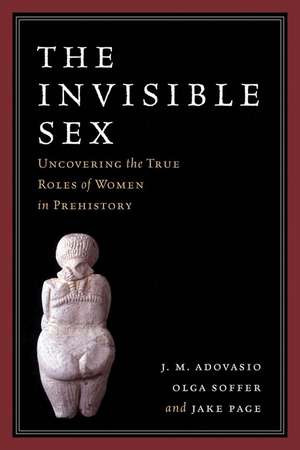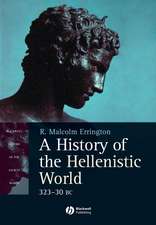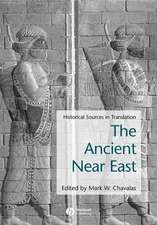The Invisible Sex: Uncovering the True Roles of Women in Prehistory
Autor J. M. Adovasio, Olga Soffer, Jake Pageen Limba Engleză Paperback – 15 feb 2009
Preț: 358.35 lei
Nou
Puncte Express: 538
Preț estimativ în valută:
68.58€ • 71.51$ • 56.99£
68.58€ • 71.51$ • 56.99£
Carte tipărită la comandă
Livrare economică 20 martie-03 aprilie
Preluare comenzi: 021 569.72.76
Specificații
ISBN-13: 9781598743906
ISBN-10: 1598743902
Pagini: 320
Ilustrații: 20
Dimensiuni: 152 x 229 x 25 mm
Greutate: 0.5 kg
Ediția:1
Editura: Taylor & Francis
Colecția Routledge
Locul publicării:Oxford, United Kingdom
ISBN-10: 1598743902
Pagini: 320
Ilustrații: 20
Dimensiuni: 152 x 229 x 25 mm
Greutate: 0.5 kg
Ediția:1
Editura: Taylor & Francis
Colecția Routledge
Locul publicării:Oxford, United Kingdom
Recenzii
"A fascinating book with a global perspective that is rare in contemporary discussions of prehistory. The Invisible Sex weaves the fundamental issues about women in remote prehistory into a broader analysis of human evolution. There are many issues about prehistoric men and women that we will never be able to answer, but this engaging and readable book gives us a useful baseline for further research. It will be much quoted and used."-Brian Fagan, University of California Santa Barbara, emeritus
"They argue persuasively that the anthropologists and archaeologists of the past were invested in the conventional sex roles of their time. This often rendered them blind to the implications of some of their finds and uninterested in the crucial roles that women probably played in prehistoric communities." -salon.com
"Helps flesh out a more plausible female role in prehistory than has been offered previously. In many ways, this book is a much-needed antidote to the past hundred years of popular and scientific writing on prehistoric human life, and avoids the cliched pitfall of veering too far into a hyper-feminist view." -Nature
"The authors offer up some less ambiguous evidence that women's roles in developing culture were at least commensurate with those of men in several important areas. Women, according other authors, had an important part to play in the agricultural revolution. Just as important, though perhaps less well appreciated, women in both ancient and modern cultures have been the ones involved most directly in producing textiles." -Natural History
"Raquel Welch in a loincloth? The frightened, helpless mama in the dioramas of Natural History museums? The Invisible Sex blows all these myths out of the cave. Written by a renowned archaeologist, an anthropologist, and a science journalist, this book disproves many theories about prehistoric females and males. It argues that women probably hunted, invented agriculture, and created spoken language, and that the womanly arts of weaving nets and baskets and clothing were critical to survival and evolution." -Bust
The Invisible Sex is science writing at its best. It has all the drama of a good mystery and grabs your attention in the same way. It is so fascinating, you don't even realize how much you are learning. - Jean M. Auel
A fascinating book with a global perspective that is rare in contemporary discussions of prehistory. The Invisible Sex weaves the fundamental issues about women in remote prehistory into a broader analysis of human evolution. There are many issues about prehistoric men and women that we will never be able to answer, but this engaging and readable book gives us a useful baseline for further research. It will be much quoted and used. - Brian Fagan, University of California Santa Barbara, emeritus
I enjoyed The Invisible Sex a lot. It is well-written, lively, coherent, and says the right things. -Sarah M. Nelson, University of Denver, emerita
They argue persuasively that the anthropologists and archaeologists of the past were invested in the conventional sex roles of their time. This often rendered them blind to the implications of some of their finds and uninterested in the crucial roles that women probably played in prehistoric communities. - Salon.com
Helps flesh out a more plausible female role in prehistory than has been offered previously. In many ways, this book is a much-needed antidote to the past hundred years of popular and scientific writing on prehistoric human life, and avoids the cliched pitfall of veering too far into a hyper-feminist view.- Nature
"They argue persuasively that the anthropologists and archaeologists of the past were invested in the conventional sex roles of their time. This often rendered them blind to the implications of some of their finds and uninterested in the crucial roles that women probably played in prehistoric communities." -salon.com
"Helps flesh out a more plausible female role in prehistory than has been offered previously. In many ways, this book is a much-needed antidote to the past hundred years of popular and scientific writing on prehistoric human life, and avoids the cliched pitfall of veering too far into a hyper-feminist view." -Nature
"The authors offer up some less ambiguous evidence that women's roles in developing culture were at least commensurate with those of men in several important areas. Women, according other authors, had an important part to play in the agricultural revolution. Just as important, though perhaps less well appreciated, women in both ancient and modern cultures have been the ones involved most directly in producing textiles." -Natural History
"Raquel Welch in a loincloth? The frightened, helpless mama in the dioramas of Natural History museums? The Invisible Sex blows all these myths out of the cave. Written by a renowned archaeologist, an anthropologist, and a science journalist, this book disproves many theories about prehistoric females and males. It argues that women probably hunted, invented agriculture, and created spoken language, and that the womanly arts of weaving nets and baskets and clothing were critical to survival and evolution." -Bust
The Invisible Sex is science writing at its best. It has all the drama of a good mystery and grabs your attention in the same way. It is so fascinating, you don't even realize how much you are learning. - Jean M. Auel
A fascinating book with a global perspective that is rare in contemporary discussions of prehistory. The Invisible Sex weaves the fundamental issues about women in remote prehistory into a broader analysis of human evolution. There are many issues about prehistoric men and women that we will never be able to answer, but this engaging and readable book gives us a useful baseline for further research. It will be much quoted and used. - Brian Fagan, University of California Santa Barbara, emeritus
I enjoyed The Invisible Sex a lot. It is well-written, lively, coherent, and says the right things. -Sarah M. Nelson, University of Denver, emerita
They argue persuasively that the anthropologists and archaeologists of the past were invested in the conventional sex roles of their time. This often rendered them blind to the implications of some of their finds and uninterested in the crucial roles that women probably played in prehistoric communities. - Salon.com
Helps flesh out a more plausible female role in prehistory than has been offered previously. In many ways, this book is a much-needed antidote to the past hundred years of popular and scientific writing on prehistoric human life, and avoids the cliched pitfall of veering too far into a hyper-feminist view.- Nature
Notă biografică
Adovasio, J. M.; Soffer, Olga; Page, Jake
Cuprins
Introduction; 1: The Beginnings; 1: The Stories We Have Been Told; 2: Origins; 3: The Importance of Being Upright; 4: Who Brought Home the Bacon?; 5: Gray Matter and Language; 2: The Road to Thoroughly Modern Millie; 6: Leaving the African Cradle; 7: Almost Altogether Truly Modern Humans; 8: The Fashioning of Women; 3: Peopling the World; 9: Cakes, Fish, and Matrilineality; 10: Seamstresses of the Far North; 11: Settling Down in America; 12: The Agricultural Evolution; 3: Conclusion Not Invisible After All
Descriere
In The Invisible Sex, the authors present an exciting new look at prehistory, arguing that women invented all kinds of critical materials, including the clothing necessary for life in colder climates, the ropes used to make rafts that enabled long-distance travel by water, and nets used for communal hunting. In this eye-opening book, a new story about women in prehistory emerges with provocative implications for our assumptions about gender today.













